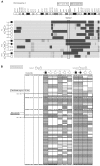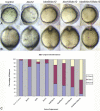Identification of a novel BBS gene (BBS12) highlights the major role of a vertebrate-specific branch of chaperonin-related proteins in Bardet-Biedl syndrome
- PMID: 17160889
- PMCID: PMC1785304
- DOI: 10.1086/510256
Identification of a novel BBS gene (BBS12) highlights the major role of a vertebrate-specific branch of chaperonin-related proteins in Bardet-Biedl syndrome
Abstract
Bardet-Biedl syndrome (BBS) is primarily an autosomal recessive ciliopathy characterized by progressive retinal degeneration, obesity, cognitive impairment, polydactyly, and kidney anomalies. The disorder is genetically heterogeneous, with 11 BBS genes identified to date, which account for ~70% of affected families. We have combined single-nucleotide-polymorphism array homozygosity mapping with in silico analysis to identify a new BBS gene, BBS12. Patients from two Gypsy families were homozygous and haploidentical in a 6-Mb region of chromosome 4q27. FLJ35630 was selected as a candidate gene, because it was predicted to encode a protein with similarity to members of the type II chaperonin superfamily, which includes BBS6 and BBS10. We found pathogenic mutations in both Gypsy families, as well as in 14 other families of various ethnic backgrounds, indicating that BBS12 accounts for approximately 5% of all BBS cases. BBS12 is vertebrate specific and, together with BBS6 and BBS10, defines a novel branch of the type II chaperonin superfamily. These three genes are characterized by unusually rapid evolution and are likely to perform ciliary functions specific to vertebrates that are important in the pathophysiology of the syndrome, and together they account for about one-third of the total BBS mutational load. Consistent with this notion, suppression of each family member in zebrafish yielded gastrulation-movement defects characteristic of other BBS morphants, whereas simultaneous suppression of all three members resulted in severely affected embryos, possibly hinting at partial functional redundancy within this protein family.
Figures




Similar articles
-
Mutations in chaperonin-like BBS genes are a major contributor to disease development in a multiethnic Bardet-Biedl syndrome patient population.J Med Genet. 2010 Jul;47(7):453-63. doi: 10.1136/jmg.2009.073205. Epub 2010 May 14. J Med Genet. 2010. PMID: 20472660
-
BBS6, BBS10, and BBS12 form a complex with CCT/TRiC family chaperonins and mediate BBSome assembly.Proc Natl Acad Sci U S A. 2010 Jan 26;107(4):1488-93. doi: 10.1073/pnas.0910268107. Epub 2010 Jan 4. Proc Natl Acad Sci U S A. 2010. PMID: 20080638 Free PMC article.
-
Autozygosity mapping of Bardet-Biedl syndrome to 12q21.2 and confirmation of FLJ23560 as BBS10.Eur J Hum Genet. 2007 Feb;15(2):173-8. doi: 10.1038/sj.ejhg.5201736. Epub 2006 Nov 15. Eur J Hum Genet. 2007. PMID: 17106446
-
Bardet-Biedl syndrome: The pleiotropic role of the chaperonin-like BBS6, 10, and 12 proteins.Am J Med Genet C Semin Med Genet. 2022 Mar;190(1):9-19. doi: 10.1002/ajmg.c.31970. Epub 2022 Apr 4. Am J Med Genet C Semin Med Genet. 2022. PMID: 35373910 Free PMC article. Review.
-
Bardet-Biedl Syndrome as a Chaperonopathy: Dissecting the Major Role of Chaperonin-Like BBS Proteins (BBS6-BBS10-BBS12).Front Mol Biosci. 2017 Jul 31;4:55. doi: 10.3389/fmolb.2017.00055. eCollection 2017. Front Mol Biosci. 2017. PMID: 28824921 Free PMC article. Review.
Cited by
-
Emphasizing the need for preconceptional, prenatal genetic counseling and comprehensive genetic testing in consanguinity: challenges and experience.Mol Genet Genomics. 2024 Oct 4;299(1):91. doi: 10.1007/s00438-024-02187-6. Mol Genet Genomics. 2024. PMID: 39365491
-
Ciliopathies.Cold Spring Harb Perspect Biol. 2017 Mar 1;9(3):a028191. doi: 10.1101/cshperspect.a028191. Cold Spring Harb Perspect Biol. 2017. PMID: 27793968 Free PMC article. Review.
-
Jumping on the Train of Personalized Medicine: A Primer for Non-Geneticist Clinicians: Part 2. Fundamental Concepts in Genetic Epidemiology.Curr Psychiatry Rev. 2014 May;10(2):101-117. doi: 10.2174/1573400510666140319235334. Curr Psychiatry Rev. 2014. PMID: 25598767 Free PMC article.
-
KinSNP software for homozygosity mapping of disease genes using SNP microarrays.Hum Genomics. 2010 Aug;4(6):394-401. doi: 10.1186/1479-7364-4-6-394. Hum Genomics. 2010. PMID: 20846928 Free PMC article.
-
Deciphering intrafamilial phenotypic variability by exome sequencing in a Bardet-Biedl family.Mol Genet Genomic Med. 2014 Mar;2(2):124-33. doi: 10.1002/mgg3.50. Epub 2013 Dec 3. Mol Genet Genomic Med. 2014. PMID: 24689075 Free PMC article.
References
Web Resources
-
- Bardet Biedl Syndrome: Multiple Alignment, http://bips.u-strasbg.fr/BBS/ (for alignment of BBS12)
-
- Ciliary Proteome Database, http://www.ciliaproteome.org/
-
- CryptoDB, http://cryptodb.org/cryptodb/ (for cryptosporidia)
-
- Cyanidioschyzon merolae Genome Project, http://merolae.biol.s.u-tokyo.ac.jp/ (for C. merolae)
References
-
- Green JS, Parfrey PS, Harnett JD, Farid NR, Cramer BC, Johnson G, Heath O, McManamon PJ, O‘Leary E, Pryse-Phillips W (1989) The cardinal manifestations of Bardet-Biedl syndrome, a form of Laurence-Moon-Biedl syndrome. N Engl J Med 321:1002–1009 - PubMed
-
- Farag TI, Teebi AS (1988) Bardet-Biedl and Laurence-Moon syndromes in a mixed Arab population. Clin Genet 33:78–82 - PubMed
-
- Farag TI, Teebi AS (1989) High incidence of Bardet-Biedl syndrome among the Bedouin. Clin Genet 36:463–464 - PubMed
-
- Moore SJ, Green JS, Fan Y, Bhogal AK, Dicks E, Fernandez BA, Stefanelli M, Murphy C, Cramer BC, Dean JC, Beales PL, Katsanis N, Bassett AS, Davidson WS, Parfrey PS (2005) Clinical and genetic epidemiology of Bardet-Biedl syndrome in Newfoundland: a 22-year prospective, population-based, cohort study. Am J Med Genet A 132:352–360 - PMC - PubMed
Publication types
MeSH terms
Substances
Associated data
- Actions
- Actions
LinkOut - more resources
Full Text Sources
Other Literature Sources
Molecular Biology Databases
Miscellaneous

